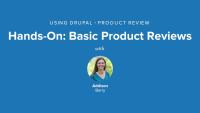This page is archived
We're keeping this page up as a courtesy to folks who may need to refer to old instructions. We don't plan to update this page.
With so much information, and so many products, on the web today, people often want to get an opinion to help rank and rate things. Should I buy this widget? Should I watch this movie? In this series, we're going to use a handful of Drupal modules to build a product review website that lets community members give their opinions, along with a way to rate their review as well. To kick things off, in this lesson we will review the Super Duper Chefs case study and discuss our implementation. This series is based on the Using Drupal, 2nd Edition book by O'Reilly Media, and uses the source code provided for that book.
See our guide Using Drupal Book by O'Reilly Media to access all of our tutorials related to this book. Each series covers a chapter (or appendix).
With so much information, and so many products, on the web today, people often want to get an opinion to help rank and rate things. Should I buy this widget? Should I watch this movie? In this series, we’re going to use a handful of Drupal modules to build a product review website that lets community members give their opinions, along with a way to rate their review as well. To kick things off, in this lesson we will:
- Review the Super Duper Chefs case study
- Discuss our implementation
Additional resources
To get started, we'll need to create a content type to use for our product reviews. Based on the Super Duper Chefs requirements, in this lesson we'll:
- Create the Product Review Content Type
- Add a Field group
- Set permissions
Additional resources
Amazon.com is one of a large number of web-based businesses that have opened up their product information databases for other sites to access. In the case of Super Duper Chefs, we want to retrieve useful data like product photos, pricing, and manufacturer information for display on our own website. The Amazon module for Drupal allows us to do just that. In this lesson we'll take a look at the Amazon module, by starting with:
- What’s Included?
- Locale
- Referral settings
- Amazon keys
Additional resources
In a previous lesson in this series, we set up a content type for our product reviews. Now, we’re ready to add a field to store a link to the product on Amazon.com. In this lesson we'll:
- Enable and configure the Amazon module
- Get our Amazon key
- Add the Product Field
Note that Amazon changes the way they manage keys over time, so the way they are generated in the lesson may have changed. Please review the official AWS Product Advertising API documentation for current key generation instructions.
Additional resources
Giving visitors a chance to evaluate and rate content is an extremely common pattern on content-rich websites. In addition to giving visitors a way to jump to the best content, it can give you a way to determine what content on your site is most effective. In this lesson we'll discuss:
- Voting API module
- Fivestar module
Additional resources
For the Super Duper Chefs site, we’ll be using both of the Fivestar module’s unique features: adding a static Rating field to the “Product review” content type for the editors to use, and attaching a voting widget to the comment form on each review for the site readers to use. That approach will keep the official rating on each review separate from the reader ratings. In this lesson we'll:
- Add the Product Rating Field
- Add the Reader Rating Field
Additional resources
Drupal’s theming system gives designers complete control over how a site’s content is rendered for a web browser, and custom themes can give any site a distinctive look. But sometimes it’s useful to make minor tweaks to a site’s appearance using nothing but CSS rules. They allow designers to tweak font sizes, colors, and so on without altering the underlying HTML that defines the site’s structure. In this lesson we'll look at:
- CSS Injector module
- Explain how this works
Additional resources
Although our “Product review” content type has all of the data we need, the individual reviews still look a bit untidy. In this lesson, we’ll do some final tweaking to make the review display look nice and tidy.
- Setting Field Display Options
- Configuring CSS Injector
Additional resources
Now that we have a few products, we really ought to add a listing page that lets visitors look over all of the products that have been reviewed, comparing official ratings with visitor ratings and sorting by various criteria. This is a perfect job for Views. In this lesson:
- Create a Product Finder view
- Display Amazon information
- Display voting results
Additional resources
Drupal’s built-in Search module offers powerful, flexible searching features and intelligent ranking of results. Behind the scenes, it’s silently building an index of all the words used in the site’s content. In this lesson we'll:
- Review the Search module settings
- Explain the importance of cron
- Discuss searching with Views
Additional resources
To transform the Product Finder page into a searchable index, we’ll be adding two new filters to the view: one that restricts the results by manufacturer, and another that restricts results to reviews that mention specific words. In this lesson, we'll:
- Add a filter
- Expose a filter
- Set permissions
Additional resources
We’re almost done! The only problem with our view now is that clicking the titles in the view links to Amazon.com instead of to our own website. Fortunately, Views provides a handy trick for just this sort of situation; we can “rewrite” the output of the Title field to create a link back to its referring node instead. In this lesson, we'll:
- Exclude a field from display
- Rewrite the output of a field
Additional resources
You've built the site that Bob and Sarah need to get their reviews going, but as always, there are ways to add more neat features. In this lesson, we'll look at a few modules you can look at adding down the road
- AdSense
- Display Suite
- Blog (core)
- Recipe
Additional resources
We’ve hit all of the major pieces of functionality that Bob and Sarah wanted. In this summary, we'll:
- Tour the Super Duper Chefs site
- Discuss our implementation points
- Review modules and resources













